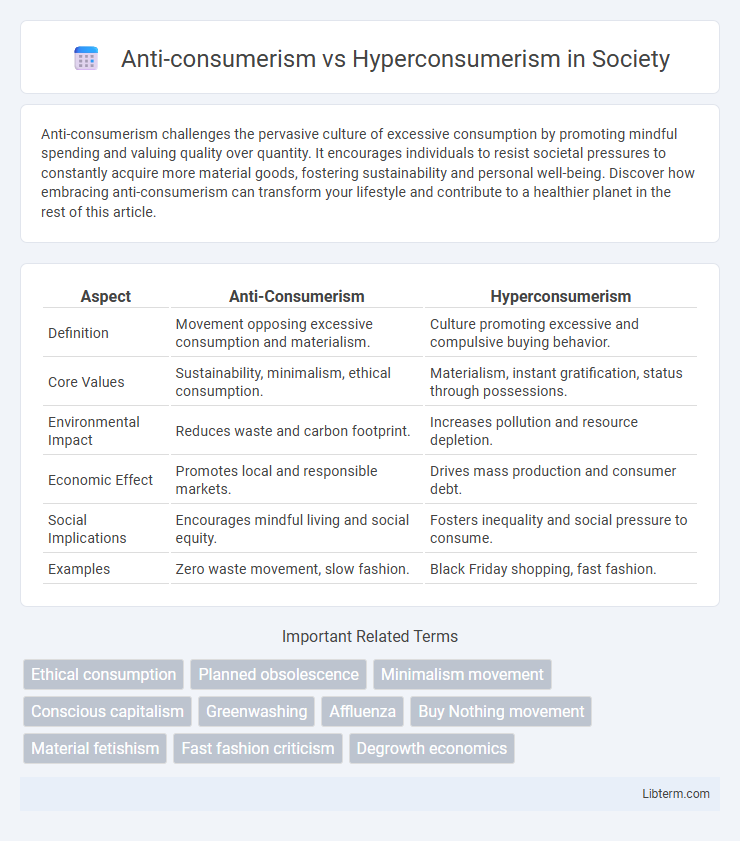Anti-consumerism challenges the pervasive culture of excessive consumption by promoting mindful spending and valuing quality over quantity. It encourages individuals to resist societal pressures to constantly acquire more material goods, fostering sustainability and personal well-being. Discover how embracing anti-consumerism can transform your lifestyle and contribute to a healthier planet in the rest of this article.
Table of Comparison
| Aspect | Anti-Consumerism | Hyperconsumerism |
|---|---|---|
| Definition | Movement opposing excessive consumption and materialism. | Culture promoting excessive and compulsive buying behavior. |
| Core Values | Sustainability, minimalism, ethical consumption. | Materialism, instant gratification, status through possessions. |
| Environmental Impact | Reduces waste and carbon footprint. | Increases pollution and resource depletion. |
| Economic Effect | Promotes local and responsible markets. | Drives mass production and consumer debt. |
| Social Implications | Encourages mindful living and social equity. | Fosters inequality and social pressure to consume. |
| Examples | Zero waste movement, slow fashion. | Black Friday shopping, fast fashion. |
Understanding Anti-Consumerism
Anti-consumerism critiques the excessive consumption patterns promoted by hyperconsumerism, emphasizing sustainability, minimalism, and ethical purchasing decisions. This movement advocates for reducing reliance on mass-produced goods and challenges the cultural norms that equate personal success with material wealth. Anti-consumerism promotes conscious living by encouraging consumers to prioritize quality over quantity and to resist advertising-driven desires.
Defining Hyperconsumerism
Hyperconsumerism is characterized by excessive and compulsive consumption driven by materialism and social status signaling. This phenomenon promotes constant acquisition of goods beyond functional needs, fueled by aggressive marketing and easy access to credit. The resulting environmental degradation and social inequality contrast sharply with anti-consumerism's emphasis on sustainability and conscious consumption.
Historical Roots of Consumer Culture
The historical roots of consumer culture trace back to the Industrial Revolution, which introduced mass production and shifted economies toward goods consumption. Anti-consumerism emerged as a critique of this culture, challenging the environmental degradation and social inequalities caused by hyperconsumerism. Key milestones include the rise of advertising in the early 20th century and post-World War II economic booms that entrenched materialism and excessive consumption patterns.
Core Values of Anti-Consumerism
Anti-consumerism emphasizes core values such as sustainability, minimalism, and ethical consumption, promoting mindful purchasing decisions to reduce environmental impact and social inequality. It rejects the excessive materialism and status-driven behavior characteristic of hyperconsumerism, advocating for quality over quantity and meaningful experiences over possessions. This movement encourages conscious awareness of corporate influence and prioritizes well-being, community, and long-term ecological balance.
Drivers Behind Hyperconsumerism
Hyperconsumerism is driven by factors such as aggressive marketing strategies, social media influence promoting aspirational lifestyles, and the psychological need for instant gratification. Economic growth and globalization increase the availability of diverse products, reinforcing consumption patterns. Technological advancements and credit accessibility further enable continuous purchasing, intensifying hyperconsumerist behavior.
Environmental Impact: A Comparative View
Anti-consumerism emphasizes reducing consumption to minimize environmental degradation by lowering carbon emissions, waste production, and resource depletion. Hyperconsumerism drives excessive resource extraction and energy use, resulting in increased pollution, habitat destruction, and a larger carbon footprint. The environmental impact contrast highlights anti-consumerism's role in promoting sustainability, while hyperconsumerism accelerates ecological harm through unsustainable consumption patterns.
Psychological Effects of Both Ideologies
Anti-consumerism often fosters mindfulness and reduced stress by encouraging minimalism and rejecting materialistic values, leading to greater life satisfaction and mental well-being. In contrast, hyperconsumerism can trigger increased anxiety, lower self-esteem, and compulsive buying behavior due to constant exposure to advertising and the pursuit of status through possessions. Both ideologies significantly influence cognitive processes and emotional health by shaping individuals' perceptions of value, identity, and social belonging.
Social Consequences and Cultural Shifts
Anti-consumerism challenges the relentless pursuit of material goods by promoting sustainable lifestyles and prioritizing well-being over possessions, leading to social movements advocating minimalism and environmental responsibility. Hyperconsumerism drives excessive consumption patterns that foster materialism, social inequality, and environmental degradation while influencing cultural shifts towards instant gratification and status-driven identities. These opposing trends reshape societal values, with anti-consumerism encouraging mindful consumption and community engagement, whereas hyperconsumerism perpetuates individualism and economic growth at the expense of social cohesion.
Case Studies: Movements and Backlashes
Anti-consumerism movements like Buy Nothing Day and the Minimalist lifestyle challenge hyperconsumerism by promoting reduced consumption and mindful purchasing habits, gaining traction in urban and online communities. Case studies reveal backlashes such as the "Black Friday" criticism, where activists highlight the environmental and social costs of mass consumerism, prompting brands like Patagonia to adopt sustainable marketing strategies. These movements underscore a growing social shift towards valuing sustainability over excess, influencing corporate policies and consumer behavior globally.
Paths Toward Conscious Consumption
Anti-consumerism promotes mindful purchasing by encouraging individuals to prioritize sustainability, ethical production, and minimalism over excessive acquisition, while hyperconsumerism drives constant demand for new products fueled by advertising and social status. Conscious consumption involves adopting behaviors such as buying second-hand, supporting local artisans, and reducing waste to counteract the environmental and social impacts of mass consumption. Emphasizing transparency in supply chains and leveraging digital tools for informed choices enables consumers to shift from compulsive buying to purposeful consumption.
Anti-consumerism Infographic

 libterm.com
libterm.com